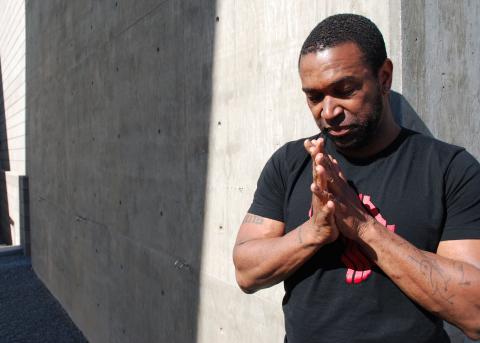By Sarah Kortemeier and Julie Lauterbach-Colby
Students use prompts drawn from Roger Bonair-Agard's "allegory of the black man at work in the synagogue" to write about the identities they inhabit.
Bonair-Agard, Roger. Gully. New York: Cypher Books, 2010.
Introduction: 5 minutes
Give students a quick introduction to Voca, the Poetry Center’s online audio/video library. Ask students why listening to poems (in addition to encountering poems on the page) might be useful. Would they prefer to hear a poem, read a poem, or both? Why?
Discussion: 10 minutes
Introduce the rhetorical device of anaphora (the repetition of a phrase at the beginnings of sentences or clauses). Then tell students that they are about to hear a poem on Voca, and ask them to listen for the poet’s use of anaphora, as well as any other images, allusions, or elements that stand out to them. Play Roger Bonair-Agard’s performance of “allegory of the black man at work in a synagogue” (above). Discuss the craft elements and images students noticed: how do these contribute to the overall meaning of the poem? How does Bonair-Agard’s speaker construct a personal identity in this poem? What do we do with the poem’s ambiguities? What are the speaker’s main conflicts? Why might Bonair-Agard have chosen to call this poem an “allegory?”
Writing Activity I: 10-15 minutes
Ask students to write responses to the following series of prompts based on “allegory of the black man at work in a synagogue”:
- List 5 things that the sounds in your name remind you of. (These may be words that rhyme with your name; things that you associate with individual sounds; or a combination.)
- Make 5 statements beginning “My name is…” You may name yourself after any person or thing you choose.
- List one sight, one sound, one taste, one smell, and one texture you remember from your childhood.
- Make 3 statements beginning “My name means…” You may use the actual etymological origins of your name; you may also make some up.
- List three things that are holy (to you).
- At the top of a new sheet of paper, write the words “My name…” When I say “start,” complete this sentence and then write for 5 more minutes without stopping, writing down everything that comes into your mind, whether it makes coherent sense or not.*
Writing Activity II: 20 minutes
Ask students to use the language they generated in Writing Activity I to create a draft of a poem. This poem may be formally similar to “allegory of the black man at work in a synagogue,” or it may take a form of the student’s choosing. Students may use as much or as little of the language generated in the prewriting prompts as they choose, and they may also add new language. There is no formal constraint for this assignment: students can write in any way that seems useful or interesting to them.
Closing: 10 minutes
Ask for volunteers to share their writing with the class.
*This prompt is based on the Surrealist technique of automatic writing.



